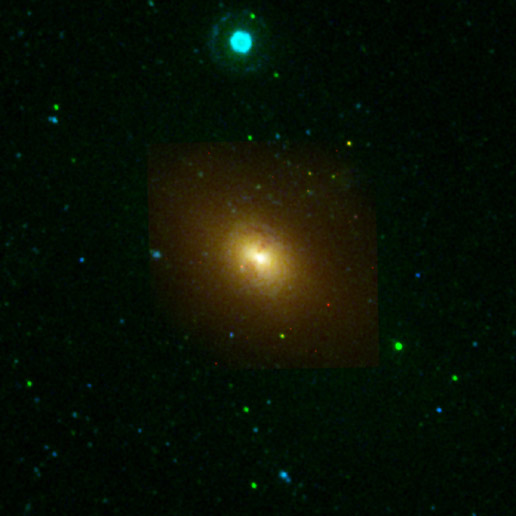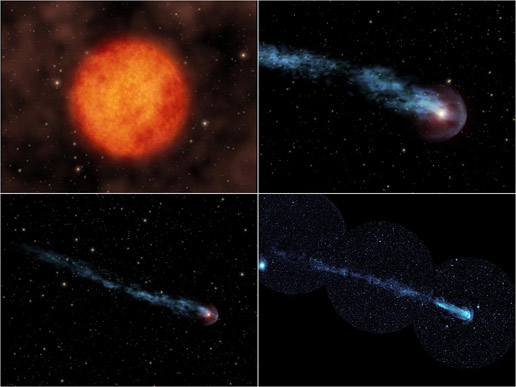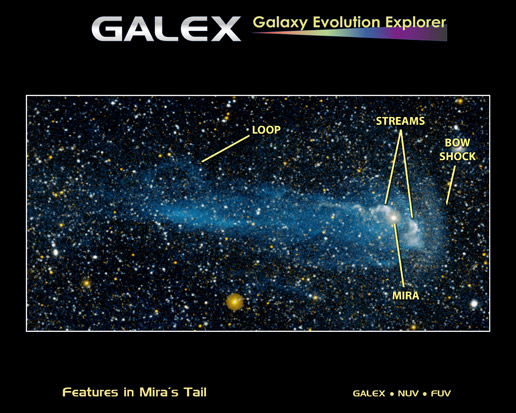Photos: Galaxy Images from NASA's GALEX Space Telescope
Elliptical Galaxy NGC 1316
This image from NASA's Galaxy Evolution Explorer shows the galaxy NGC 1316, located about 62 million light-years away in the constellation Fornax. The elliptical-shaped galaxy may be in the late stages of merging with a smaller companion galaxy. The Galaxy Evolution Explorer data was taken in December 2003.
A Real Shooting Star
This artist's animation illustrates a star flying through our galaxy at supersonic speeds, leaving a 13-light-year-long trail of glowing material in its wake. The star, named Mira (pronounced my-rah) after the Latin word for "wonderful," sheds material that will be recycled into new stars, planets and possibly even life. NASA's Galaxy Evolution Explorer discovered the long trail of material behind Mira during its survey of the entire sky in ultraviolet light. This image was released Aug. 15, 2007.
Supersonic Bullet
A bullet traveling through air at about 1.5 times the speed of sound can be seen in this image. NASA's Galaxy Evolution Explorer captured an image of a racing star, called Mira, which resembles this bullet photo. The ultraviolet image shows a gigantic shock wave, called a bow shock, in front of the star, and an enormous, 13-light-year-long trail of turbulence in its wake. Nothing like this tail has ever been seen before. This image was created using an instrument called a shadowgraph. The image was released Aug. 15, 2007.
Anatomy of a Shooting Star
A close-up view of a star racing through space faster than a speeding bullet can be seen in this image from NASA's Galaxy Evolution Explorer. The star, called Mira (pronounced My-rah), is traveling at 130 kilometers per second, or 291,000 miles per hour. As it hurls along, it sheds material that will be recycled into new stars, planets and possibly even life. This image was released Aug. 15, 2007.
Magnificent M81
In a new ultraviolet image, the magnificent M81 spiral galaxy is shown at the center. The orbiting observatory spies the galaxy's "sizzling young starlets" as wisps of bluish-white swirling around a central golden glow. The tints of gold at M81's center come from a "senior citizen" population of smoldering stars. This image was released May 1, 2007.
Scene of Multiple Explosions
This composite image shows Z Camelopardalis, or Z Cam, a double-star system featuring a collapsed, dead star, called a white dwarf, and a companion star, as well as a ghostly shell around the system. The massive shell provides evidence of lingering material ejected during and swept up by a powerful classical nova explosion that occurred probably a few thousand years ago. This image was released March 7, 2007.
Explosions — Large and Small
This animation shows an artist's concept of Z Camelopardalis (Z Cam), a stellar system featuring a collapsed, dead star, or white dwarf, and a companion star. The white dwarf, the bright white object within the disk on the left, sucks matter from its more sedate companion star, on the right. The stolen material forms a rotating disk of gas and dust around the white dwarf. This image was released March 7, 2007.
Breaking space news, the latest updates on rocket launches, skywatching events and more!
Older Galaxy Pair Has Surprisingly Youthful Glow
A pair of interacting galaxies might be experiencing the galactic equivalent of a mid-life crisis. For some reason, the pair, called Arp 82, didn't make their stars early on as is typical of most galaxies. Instead, they got a second wind later in life — about 2 billion years ago — and started pumping out waves of new stars as if they were young again. This image was released Jan. 10, 2007.
Black Hole Grabs Starry Snack
This artist's concept shows a supermassive black hole at the center of a remote galaxy digesting the remnants of a star. NASA's Galaxy Evolution Explorer had a "ringside" seat for this feeding frenzy, using its ultraviolet eyes to study the process from beginning to end. This image was released Dec. 4, 2006.
Baby Galaxies in the Adult Universe
This artist's conception illustrates the decline in our universe's "birth-rate" over time. When the universe was young, massive galaxies were forming regularly, like baby bees in a bustling hive. In time, the universe bore fewer and fewer "offspring," and newborn galaxies (white circles) matured into older ones more like our own Milky Way (spirals).

Tariq is the award-winning Editor-in-Chief of Space.com and joined the team in 2001. He covers human spaceflight, as well as skywatching and entertainment. He became Space.com's Editor-in-Chief in 2019. Before joining Space.com, Tariq was a staff reporter for The Los Angeles Times covering education and city beats in La Habra, Fullerton and Huntington Beach. He's a recipient of the 2022 Harry Kolcum Award for excellence in space reporting and the 2025 Space Pioneer Award from the National Space Society. He is an Eagle Scout and Space Camp alum with journalism degrees from the USC and NYU. You can find Tariq at Space.com and as the co-host to the This Week In Space podcast on the TWiT network. To see his latest project, you can follow Tariq on Twitter @tariqjmalik.










